By Frank Giles
The U.S. Environmental Protection Agency (EPA) and U.S. Army Corps of Engineers announced the latest attempt to define the waters of the United States (WOTUS) under the Clean Water Act. The final rule was announced on Dec.30.
The final rule restores essential water protections that were in place prior to 2015 under the Clean Water Act for traditional navigable waters, the territorial seas, interstate waters, as well as upstream water resources that significantly affect those waters. According to the agencies, the new rule would allow for updates: “The rule returns to a reasonable and familiar framework founded on the pre-2015 definition with updates to reflect existing Supreme Court decisions, the latest science, and the agencies’ technical expertise. It establishes limits that appropriately draw the boundary of waters subject to federal protection.”
The latest WOTUS definition is the third attempt that started with Obama in 2015. Trump replaced that definition in 2020. President Biden’s new definition will add back protections to ephemeral streams, which flow in response to rain. The Trump administration rule had excluded ephemeral streams from the regulation.

“There is overwhelming scientific information demonstrating the effects ephemeral streams can have on downstream waters and the effects wetlands can have on downstream waters when they do not have a continuous surface connection,” the rule says.
Opposition groups argue the rule relies on vague terms that will make it difficult for any business or individual trying to comply with the Clean Water Act. Among those terms is “significant nexus,” which establishes a scientific connection between smaller water bodies, such as tributaries, and larger, more traditional navigable waters such as rivers. This makes the smaller water bodies jurisdictional and subject to the Clean Water Act.
“This rule does not provide the needed clarity and certainty that the regulated community has long called for. This rule allows the federal government to expand their jurisdictional reach over private property,” said Courtney Briggs, senior director of government affairs for the American Farm Bureau Federation when the rule was announced. “It is clear that the agencies have doubled down on their use of the troubling significant nexus test, which will require landowners to hire environmental consultants, attorneys and engineers to ensure that they are in compliance.”
Rule proponents argue traditional exemptions for agriculture prior to 2015 were restored and converted agricultural land would be exempted. EPA noted wetlands converted to croplands prior to Dec. 23, 1985, are excluded from regulation.
Some lawmakers had asked EPA to delay the rule until the Supreme Court provides its opinion on Sackett v. EPV in the spring. The case partly addresses questions about what qualifies as a jurisdictional wetland.
“We will be looking to the Supreme Court for a decision in the Sackett case, which will provide some clarity on the use of the significant nexus test,” Briggs said. “And the agencies have stated that today’s rule is a durable rule, but it is very likely that they will have to make changes to the rule in response to a decision from the high court.”









